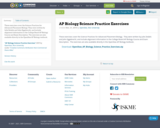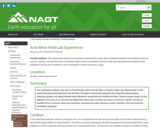
Series of videos that can be used in an AP Biology Labs class created by Paul Anderson- Bozeman Science
- Subject:
- Biology
- Life Science
- Material Type:
- Lecture
- Provider:
- Bozeman Science
- Date Added:
- 11/23/2016

Series of videos that can be used in an AP Biology Labs class created by Paul Anderson- Bozeman Science

These exercises cover the Science Practices for Advanced Placement Biology. They were written by Julie Zedalis and John Eggebrecht, and include alignment information to the College Board AP Biology Course and Exam Description. The exercises are also available directly in the OpenStax AP Biology textbook.

Paul Anderson's video play list of videos that can be used in a AP Biology Science Practices course

Series of videos that can be used in a AP Biology Video Essentials class created by Paul Anderson- Bozeman Science

Anatomy and Physiology Lab I slide decks created by Steven Lee M.S. Pathology, FTCC. The PowerPoints include labeled body images to assist students in identifying body parts. Nicole Shaw is only responsible for assisting Steven with licensing his work under an open license and uploading content to the Commons.

Anatomy and Physiology Lab I slide decks created by Steven Lee M.S. Pathology, FTCC. The PowerPoints include labeled body images to assist students in identifying body parts. Nicole Shaw is only responsible for assisting Steven with licensing his work under an open license and uploading content to the Commons.

This resource is a video abstract of a research paper created by Research Square on behalf of its authors. It provides a synopsis that's easy to understand, and can be used to introduce the topics it covers to students, researchers, and the general public. The video's transcript is also provided in full, with a portion provided below for preview:
"Immune checkpoints are an effective way that cancers evade the immune system, but they're not the only one. In the case of pancreatic ductal carcinoma, or PDAC, tumor fibrosis also plays an important role. To understand how fibrosis might translate to poor outcomes among patients with PDAC, researchers examined the ARF6-AMAP1 molecular pathway, which research suggests is activated during fibrosis. Findings revealed that AMAP1 correlated with elevated expression of PD-L1, a molecule that tumor cells present on their surface to elude attack by the immune system. AMAP1 was also linked to elevated fibrosis. Consistently, silencing AMAP1 in a mouse model of human PDAC reduced PD-L1 and fibrosis in their tumors. Suppressing the ARF6-AMAP1, therefore, could be one way to ensure that PDAC tumors can’t hide from immune defenses, offering the prospect of more effective immunotherapies for patients with pancreatic ductal carcinoma..."
The rest of the transcript, along with a link to the research itself, is available on the resource itself.

This resource is a video abstract of a research paper created by Research Square on behalf of its authors. It provides a synopsis that's easy to understand, and can be used to introduce the topics it covers to students, researchers, and the general public. The video's transcript is also provided in full, with a portion provided below for preview:
"The transcription factor ATF5 plays a vital role in the formation of several cancers, including breast, lung, ovarian, pancreatic, rectal, and liver cancer. But ATF5’s function in esophageal cancer—one of the most common forms of cancer worldwide—remains unclear. To find out, researchers monitored the activity of ATF5 in esophageal cancer tissues. Much like in other cancers, ATF5 was upregulated in esophageal cancer tissues cultured in the lab, and ATF5 overexpression promoted the proliferation, migration, and invasiveness of esophageal cancer cells. Silencing ATF5, however, inhibited these abilities. In fact, in mice, silencing ATF5 hampered tumor growth. ATF5’s role as a lever that triggers tumor growth is believed to occur through an interaction with HIF1, a protein complex also known to promote the growth and spread of tumors. These findings suggest that the known anti-cancer effects of silencing ATF5 might also be powerful against esophageal cancer..."
The rest of the transcript, along with a link to the research itself, is available on the resource itself.

Learn more about ATP: how it stores energy, and how that energy is released when it's converted to ADP and phosphate. Created by Sal Khan.

The goal of this lesson is to introduce students who are interested in human biology and biochemistry to the subtleties of energy metabolism (typically not presented in standard biology and biochemistry textbooks) through the lens of ATP as the primary energy currency of the cell. Avoiding the details of the major pathways of energy production (such as glycolysis, the citric acid cycle, and oxidative phosphorylation), this lesson is focused exclusively on ATP, which is truly the fuel of life. Starting with the discovery and history of ATP, this lesson will walk the students through 8 segments (outlined below) interspersed by 7 in-class challenge questions and activities, to the final step of ATP production by the ATP synthase, an amazing molecular machine. A basic understanding of the components and subcellular organization (e.g. organelles, membranes, etc.) and chemical foundation (e.g. biomolecules, chemical equilibrium, biochemical energetics, etc.) of a eukaryotic cell is a desired prerequisite, but it is not a must. Through interactive in-class activities, this lesson is designed to spark the students’ interest in biochemistry and human biology as a whole, but could serve as an introductory lesson to teaching advanced concepts of metabolism and bioenergetics in high school depending on the local science curriculum. No supplies or materials are needed.

In this seminar you will read closely and analyze the structure of ATP- Adenosine Triphosphate. You will curate your own information about the importance of ATP in a cell by listening and reading text as to what the experts have to say. By modeling the function of ATP in an inquiry lab you can accurately identify the various levels of cellular work done by Adenosine Triphosphate.StandardsBIO.A.3.1.1 Describe the fundamental roles of plastids (e.g., chloroplasts) and mitochondria in energy transformations.BIO.A.3.2.1 Compare and contrast the basic transformation of energy during photosynthesis and cellular respiration.BIO.A.3.2.2 Describe the role of ATP in biochemical reactions

ATP synthase and its role in mitochondria during respiration and chloroplasts during photosynthesis.

This resource is a video abstract of a research paper created by Research Square on behalf of its authors. It provides a synopsis that's easy to understand, and can be used to introduce the topics it covers to students, researchers, and the general public. The video's transcript is also provided in full, with a portion provided below for preview:
"The non-receptor tyrosine kinase Abelson (Abl) is a key player in oncogenesis, causing diseases including chronic myelogenous and acute lymphoblastic leukemia. Drugs targeting Abl kinase activity serve as paradigms of targeted therapy. Drosophila is an ideal model for studying Abl’s function because there is only a single fly Abl family member. In flies, Abl is essential for embryonic morphogenesis, playing diverse roles in embryonic and adult viability. To examine the role of the intrinsically disordered region (IDR) of Abl, researchers deleted the IDR in Drosophila. They found that Abl lacking the IDR was not able to rescue the roles of Abl in viability and embryonic morphogenesis. The IDR was also essential for cell shape changes and cytoskeletal regulation during embryonic morphogenesis and, surprisingly, for modulating protein stability..."
The rest of the transcript, along with a link to the research itself, is available on the resource itself.

The Bee Cause Project connects bees and their keepers with communities and classrooms in order to share the life-giving lessons of our humble friends, the bees. Our shared habitat is in trouble, and bees have the tools to help us make a world fit for people and pollinators. For students of all ages, a look into a hive can revolutionize their understanding of our food system while working together towards a common goal. The Bee Cause Project delivers teaching tools to communities and classrooms so long looks into a hive turn into STEM exploration, career development, and the curiosity that fuels change. Join us in building the next generation of environmental stewards!

In this activity, students work with paleoclimate proxy data (d18O, CH4, CO2)from the Byrd and GISP2 ice cores to investigate millennial-scale climate changes during the Last Glacial/Deglacial time periods. Students must prepare a publication quality plot of the data and answer several questions about the similarities and differences between the time-series (north-south phasing, amplitude, symmetry) and use this information to assess the bipolar see-saw mechanism for abrupt climate changes. Students are encouraged to read two journal articles for more information and to synthesize their results with other information from lectures and earlier readings.
(Note: this resource was added to OER Commons as part of a batch upload of over 2,200 records. If you notice an issue with the quality of the metadata, please let us know by using the 'report' button and we will flag it for consideration.)

This document uses headings to allow students to begin the search with either the codon or the amino acid.

This is a computer-based activity in which students retrieve data from websites maintained by the US Geological Survey (USGS) and the National Weather Service (NWS), and then use that data to test different hypotheses regarding streamflow and precipitation. Students import data from web sites into a spreadsheet program where they can construct scatter plots and perform simple statistical tests. The activity has two components, the first focusing on relations between streamflow and drainage basin characteristics (drainage area, slope, precipitation), the second focusing on trends in annual precipitation at two locations in the USA: Burlington, VT, and Boulder, CO. As part of the second component, students conduct a statistical test to determine if the long-term trends in precipitation are significant.
(Note: this resource was added to OER Commons as part of a batch upload of over 2,200 records. If you notice an issue with the quality of the metadata, please let us know by using the 'report' button and we will flag it for consideration.)

This jigsaw style exercise challenges new geomorphology students to collect topographic data and analyze its accuracy and precision.
(Note: this resource was added to OER Commons as part of a batch upload of over 2,200 records. If you notice an issue with the quality of the metadata, please let us know by using the 'report' button and we will flag it for consideration.)

Intended Audience: This activity was used for an introductory Geochemistry class, which contained students from sophomore level to master's students. We took the trip in mid-October, about as late as possible in Vermont, after they had gained some previous field experience and lab work in addition to an in introduction to these principles in class.
(Note: this resource was added to OER Commons as part of a batch upload of over 2,200 records. If you notice an issue with the quality of the metadata, please let us know by using the 'report' button and we will flag it for consideration.)

This video follows biologist Gretchen Hofmann as she studies the effects of ocean acidification on sea urchin larvae.